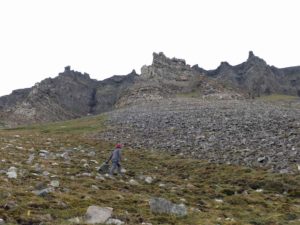 Hei! After two weeks on Svalbard, I’m still digesting everything that I learned and experienced. I had a fantastic time such that it was really difficult to say goodbye to everyone (and our cozy dinners). It was wonderful to be around other plant oriented people and learn not only about the native flora, ecosystem, and environment of Svalbard, but about everyone’s expertise and work style. The course itself was jam packed with science and lab work, which was very exciting. I joined the course to learn more about functional traits, leaf temperatures and photosynthesis, data management, and science communication and this course left me inspired and motivated. One of my favorite aspects of the course was working with others towards a common goal. Most of my research has been independent and/or working under a PI, so working together with other scientists was exciting.
Hei! After two weeks on Svalbard, I’m still digesting everything that I learned and experienced. I had a fantastic time such that it was really difficult to say goodbye to everyone (and our cozy dinners). It was wonderful to be around other plant oriented people and learn not only about the native flora, ecosystem, and environment of Svalbard, but about everyone’s expertise and work style. The course itself was jam packed with science and lab work, which was very exciting. I joined the course to learn more about functional traits, leaf temperatures and photosynthesis, data management, and science communication and this course left me inspired and motivated. One of my favorite aspects of the course was working with others towards a common goal. Most of my research has been independent and/or working under a PI, so working together with other scientists was exciting.
I was part of the leaf temperature and photosynthesis group. We sampled plants with their roots intact at two sites, the elevational gradient and the bird cliffs. Above is a photo of one of my group members, Ilaine Matos, searching for plants with large leaves to take back to the lab. Once back, we use Licor chambers to clamp down on the leaf and take measurements of photosynthesis and leaf temperatures, controlling for carbon dioxide and relative humidity, and changing the temperatures from 0-50C at 5C intervals (pictured below).
One aspect of my goals in this course was to learn more about science communication, specifically local perception of climate change in Longyearbyen, I surveyed people at their homes and the bar. Although I feel that I could have surveyed more locals if I didn’t keep talking to them during their survey, I was pleasantly surprised that everyone my group asked (about 8 people total) were willing if not highly interested in taking the survey. The locals of Svalbard showed that they were concerned about climate change and associated their actions of climate change to living a more eco-friendly lifestyle instead of focusing on policy and greater life style changes associated with climate change. Many locals commented on annual changes they noticed from years prior, such as a much rainier summer, and were well informed about the mechanisms of changing climate causing avalanches around town. Some locals I surveyed were newly established locals, which getting their views is just as important. Perception changes with each generation and understanding what the new generation of people on Svalbard understand and perceive can shape policy and attitude about climate change. If the new generation of locals experience wet summers, the perception of how climate change impacts their life might not be as strong as someone who remember summers differently.
While I had different expectations of the process of gathering data on local perception of climate change, I thought surveying people on Svalbard was very valuable both collecting information and inciting their climate change narrative and statement. From the conversations with locals, it seems like this survey got some people to self examine their views regarding climate change, and perhaps read and research more about climate change. Perhaps applying this approach to our personal research can help involve communities and increase their understanding of why scientists are working nearby.
#ArcticSummer #PFTC4 #Svalbard2018
